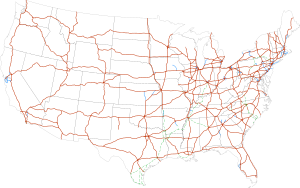Infrastructure

Transportation
Personal transportation is dominated by automobiles, which operate on a network of 4 million miles (6.4 million kilometers) of public roads. The United States has the world's second-largest automobile market, and has the highest vehicle ownership per capita in the world, with 816.4 vehicles per 1,000 Americans (2014). In 2017, there were 255,009,283 non-two wheel motor vehicles, or about 910 vehicles per 1,000 people.
The civil airline industry is entirely privately owned and has been largely deregulated since 1978, while most major airports are publicly owned. The three largest airlines in the world by passengers carried are U.S.-based; American Airlines is number one after its 2013 acquisition by US Airways. Of the world's 50 busiest passenger airports, 16 are in the United States, including the busiest, Hartsfield–Jackson Atlanta International Airport.
Energy
The United States energy market is about 29,000 terawatt hours per year. In 2005, 40% of this energy came from petroleum, 23% from coal, and 22% from natural gas. The remainder was supplied by nuclear and renewable energy sources.
Since 2007, the total greenhouse gas emissions by the United States are the second highest by country, exceeded only by China. The United States has historically been the world's largest producer of greenhouse gases, and greenhouse gas emissions per capita remain high.
Comments
Post a Comment